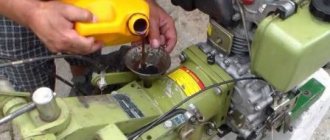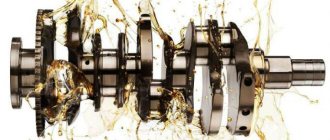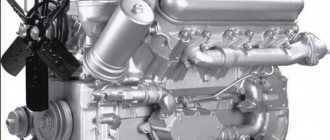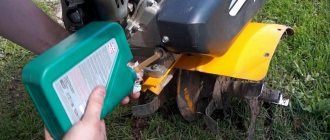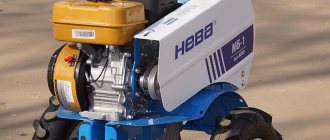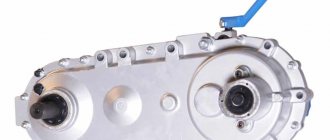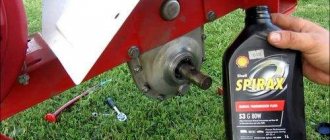Specific Requirements
Most modern walk-behind tractors (the rating of walk-behind tractors can be studied in this article) are equipped with four-stroke gasoline engines that do not have an oil pump in their design.
The lower head of the connecting rod, which is a sliding bearing, is lubricated by scooping up oil with a special protrusion on the lower cover of the connecting rod; the crankshaft main bearings, gas distribution mechanism and cylinder-piston group are lubricated by the resulting splashes.
Also, these engines have unstable temperature conditions due to air cooling.
For more information about the 4-stroke engine, watch the video:
Thus, engine oil for 4-stroke walk-behind tractor engines must meet the following requirements:
- Low kinematic viscosity over a wide temperature range is necessary to avoid oil starvation when the engine warms up to operating temperature.
- The use of viscous oils in engines that do not have pressure lubrication can lead to scuffing on the surface of the connecting rod journal, followed by envelopment of the metal in this place and jamming of the engine.
- The stable composition of the antifriction and extreme pressure additive package will allow the oil to retain its properties for a long time during regular heating-cooling cycles during the operation of the walk-behind tractor.
- High strength of the oil film is necessary to protect the cylinder-piston group from scuffing when the engine overheats during hard work in hot weather.
- The cleaning properties provided by the appropriate additive package should counteract the formation of sediment and varnish formations in the engine pan and on oil-wet surfaces.
- Low coking is relevant for air-cooled engines, since the oil entering the piston ring area is heated in this place to a temperature of 270-300 degrees.
- The formation of carbon deposits will lead to loss of mobility of the piston rings and a decrease in compression with simultaneous excessive oil consumption.
Based on these requirements, we can describe the technical requirements that oil for 4-stroke walk-behind tractor engines must meet as follows:
- High-temperature viscosity class according to SAE is no more than 30 in moderate climates, 40 in hot climates. Low-temperature viscosity index – no more than 10W. These requirements are met by common oils of types 10W30, 5W30, 0W30, 5W40, 10W40 (the last two - at temperatures of 30 degrees or more).
- Purely summer options - SAE 30, SAE 40. You should carefully read the characteristics of the oils: a number of specialized oils for garden equipment with a viscosity of 5W30 are intended exclusively for winter use.
- Oil base: synthetic or semi-synthetic, since mineral oils are practically not found in the indicated viscosity ranges. In addition, they have significantly worse stability compared to synthetics and semi-synthetics.
- A number of lubricant manufacturers have special lines of mineral-based oils for garden equipment; in this case, the low cost has a downside in the form of the need for frequent replacement.
- API quality class (a complex parameter that determines the anti-friction, extreme pressure and detergent properties of motor oil, as well as many other parameters) is not lower than SG.
You need to understand that all the requirements for motor oils for walk-behind tractors Cayman, Texas, Foreman, Viking, Sadko, Don, Profi, Carver and Husqvarna are met by common automobile oils; the only difference may be its consumption and the amount of carbon deposits formed during long-term operation in an air-cooled engine .
For this reason, although this material considers specialized lubricants, if it is not possible to purchase them, you can always use automotive motor oils that meet the described requirements.
Composition and scope of application
Now let's talk about the technical characteristics and scope of application of TAD 17 and TEP oils for car transmissions. Mineral oil TAD 17i is used today by many of our compatriots. This product is all-season and versatile.
The lubricant is used to process gears of the following types:
- hypoid;
- worm;
- cylindrical;
- spiral-conical;
- conical
Since such transmissions operate under high load conditions, they require high-quality and effective lubrication. Due to the technical properties, indicators and standards to which the product meets, its use is allowed in industrial equipment, in the box of Gazelle and other vehicles, agricultural machinery, electric vehicles, etc.
According to the standard, this product complies with GOST 23652-79, as well as the Russian class TM-5-18. The number 5 means that the gear lubricant belongs to the fifth group, the products of which are characterized by extreme pressure characteristics. Accordingly, TAD 17 or TAP liquids are multifunctional. According to the viscosity class, the consumable substance belongs to class 18. If we consider the API standard, then this product belongs to class GL-5. Its use allows you to ensure the operating condition of the transmission system at air temperatures down to -25 degrees. The maximum operating temperature of the lubricant varies around 130-140 degrees.
During the production of the product, residual and distillate elements are added to the lubricant. The base of consumables consists of depressant and sulfur-phosphorus-containing additives, which have multifunctional characteristics. Therefore, the product TAD 17 has excellent performance characteristics.
The manufacturer obtains distillate elements through fractional distillation of fuel oil. To prevent foaming of the working fluid during operation, the manufacturer adds anti-foam additives to the composition. According to the decoding, the TAD product is designated as an automobile transmission distillate fluid. The letter “I” after the numbers indicates the presence of a complex additive in the product.
The Killer Fish channel in its video showed the process of testing a lubricant at low and high temperatures.
What kind of oil to fill
It is necessary to fill in oil together with the lubrication of all parts, as well as with changing the oil in the engines.
What oil to pour into the walk-behind tractor gearbox and how much depends on various nuances, including the season of operation.
The engines are filled with motor oil, which cannot be poured into the gearbox.
The choice of oil depends both on the season in which the work is carried out and on the data specified in the operating instructions.
For walk-behind tractor models, transmission oil is distributed according to GOST:
This is a standard that is prescribed according to the relevant GOST 23652-79.
The oil for the Neva walk-behind tractor must be of high quality and from a good manufacturer - this is a prerequisite.
It is worth considering that each oil is used only during the allotted period. For example, TEP-15 is used in the summer. The minimum temperature limit is -5 degrees. If the temperature is lower, then you will have to use TM-5, which has a minimum of 25 degrees below zero. These oils are also used in various modifications.
https://youtube.com/watch?v=NC1ES9vYo20
Repairs and malfunctions
If repair work is necessary, a complete disassembly of the mechanism will be required.
A thorough cleaning with draining of the lubricant is also required first. Only after this the unit is disassembled and inspected visually with parts checked. If there is a need to replace a part, you will have to buy a native element or an analogue, which is provided for this Neva model. This is interesting: changing the oil in a walk-behind tractor.
Common breakdowns:
- the spring or retainers are damaged. After replacement, adjustments are made;
- The switching system has lost settings. The screws are loosened and tightened again after engaging first gear;
- oil began to ooze. The oil seals are being replaced;
- jams. Chain change required;
- no transmission fixation. Replacing the fork brush device.
It is worth considering that most problems can be avoided if you constantly carry out a full check and technical inspection. It is also important to remember and not violate all prescribed operating conditions.
How much to fill?
Another important point is the amount of oil needed. Before answering the question - how much oil should be poured into the gearbox of a walk-behind tractor, for example Crosser, VIKING, Forza, Sadko, Don, Huter, Profi, LANDER, Champion, Carver, you must first check the oil level in the gearbox. To do this, you need to perform certain actions:
- It is necessary to place the walk-behind tractor on a flat surface so that its wings are strictly parallel to this surface.
- We take a wire or rod about 70 cm long, which will act as an oil dipstick.
- We bend the improvised probe into an arc.
- We insert the resulting dipstick into the filler hole to the very end, i.e. all the way. After that we pull it back out.
If the wire is 30 cm deep in oil, then this is the optimal indicator, i.e. no need to add oil. If it is a little less, then it is necessary to top up within these values.
If the gearbox is completely dry, then you will need at least two liters of gear oil.
Periodically changing the oil in the gearbox is extremely important, not only because it is recommended by the manufacturer, but also for a number of other reasons. In particular, during the operation of the walk-behind tractor, foreign metal particles are formed in the oil located in the gearbox.
They arise from friction and contact between the components of the walk-behind tractor, which gradually crumble, and all this metal chips end up in the oil. Thus, the oil begins to thicken, which leads to unstable operation of the walk-behind tractor, and subsequently to failure of the gearbox.
That is why timely changing the oil in the gearbox is a necessary preventive measure to avoid repairs in the future.
Indeed, it is much more logical to spend an amount of up to one thousand rubles on the purchase of gear oil than to spend much more money on expensive repairs or a complete replacement of the gearbox.
Homemade trailers for walk-behind tractors, which you can make yourself, are very popular.
You may also be interested in the article about the Dingo T 150 snowmobile.
How to choose gear oil
When choosing gear oil for the gearbox, you should rely on the information specified in the operating manual for the walk-behind tractor or cultivator. The use of oil brands not included in the recommended list will lead to accelerated wear of gearbox parts.
| Vehicle model | Used transmission oils | Filling volume in gearbox |
| Motor cultivator MK70 | filled with Litol-24 grease, which does not require replacement during the entire service life of the product | — |
| Motor cultivator MK100 | filled with Litol-24 grease, which does not require replacement during the entire service life of the product | — |
| Motor cultivator MK200 | SAE85W-90 API GL-5 | 1.15 l |
| TM-5 GOST 17479.2-85 | ||
| Motoblock MB2 CS: GO | TSp-15K (80w90), | 2.2 l |
| TEP-15 (-5°С to 35°С) GOST 23652-79 (SAE90 API GI-2), | ||
| TM-5 (-5°C to 25°C) GOST 17479.2-85 (SAE90 API I-5) | ||
| Motoblock MB Compact | SAE85W-90 API GL-5 | 1.15 l |
| TM-5 GOST 17479.2-85 | ||
| TSp-15K (80w90) | ||
| Motoblock MB2 | TSp-15K (80w90) | 2.2 l |
| TEP-15 (-5ºС to 35ºС) GOST 23652-79 (SAE90 API GI-2) | ||
| TM-5 (-5ºС to.25ºС) GOST 17479.2-85 (SAE90 API GI-5) | ||
| Motoblock MB23 | TSp-15K (80w90) | 2.2 l |
| TEP-15 (-5ºС to 35ºС) GOST 23652-79 (SAE90 API GI-2) | ||
| TM-5 (-5ºС to.25ºС) GOST 17479.2-85 (SAE90 API GI-5) | ||
| Motoblock MB1 MultiAGRO | SAE85W-90 API GL-5 | 1.5 l |
| TM-5 (from 25 to 35) GOST 17479.2-85 | ||
| TSp-15K (80w90) | ||
| Motoblock MB2 MultiAGRO | SAE85W-90 API GL-5 | 1.5 l |
| TM-5 (from 25 to 35) GOST 17479.2-85 | ||
| TSp.15K (80w90) | ||
| Motoblock MB23 MultiAGRO | SAE85W-90 API GL-5 | 1.5 l |
| TM-5 (from 25 to 35) GOST 17479.2-85) | ||
| TSp-15K (80w90) |
How to change the oil in a motor cultivator gearbox
Maintenance of the gearbox of the Neva MK200 motor-cultivator should be performed every 250 hours of operation. It is better to change the oil in the gearbox immediately after operating the equipment, since it is easier to drain the oil during this period.
In order to change the oil in the gearbox of a motor cultivator, you should perform the following steps:
- Place the cultivator in a vertical position
- Place a container of at least 2 liters under the gearbox
- Unscrew the breather plug and clean it of dirt.
- Unscrew the oil drain screw and drain the oil from the gearbox
- After draining the oil, screw in the oil drain screw with the gasket and tighten the screw. Dispose of the oil at a waste oil collection point.
- Pour 1.15 liters of fresh transmission oil of the appropriate brand and operating temperature through the hole under the breather plug.
- Screw in the breather plug.
How to make a replacement
Periodic maintenance of the gearbox and engine includes timely oil changes.
Oil is poured into the cultivator through a special hole; to simplify the procedure, a watering can is required.
In the gearbox
In most cases, any gear oil can be used to lubricate the gearbox. The replacement procedure is carried out as follows:
- The device is located on a horizontal plane and tilted slightly. This simplifies the filling procedure.
- A probe is inserted into the hole on the gearbox. It is required to determine the level of old substance.
To replenish the oil level in the gearbox, new oil is added. About two liters are poured into a completely dry container. Some models are equipped with a special hole to remove old material, which may contain a large amount of impurities.
In the engine
Changing the engine oil is carried out depending on the manufacturer's instructions. Engine oil is changed taking into account the following points:
- The first replacement is carried out after the engine has been broken in. It is carried out exclusively at idle, because Excessive load can cause wear of the main structural elements.
- Some manufacturers recommend replacement at intervals of 40 hours of operation. The lubricant must be replaced after a period of winter operation.
- Before carrying out the actual replacement, it is recommended to warm up the walk-behind tractor. This is required to increase the fluidity of the substance. In this case, the walk-behind tractor is installed in a horizontal plane. There should be a drain tube at the bottom of the structure; after unscrewing the plug, the old substance is removed.
- After draining the old substance, the plug is screwed back on. There is a filler neck in the upper part of the structure; the level is controlled using a dipstick.
After checking the lubricant level, you can tighten the plug and turn on the engine. The first few minutes need to be run-in at idle speed, because... It takes time to lubricate all structural elements.
Do I need to add oil to gasoline?
You can determine whether oil needs to be added to the cultivator’s gasoline by studying the basic parameters of the device. In most cases, dilution is carried out for a two-stroke engine; recommendations regarding proportions are taken into account. The operation of a four-stroke engine is ensured when refueling with pure gasoline.
It is prohibited to mix gasoline with oil to refuel a four-stroke engine. Such a mixture will cause malfunctions within a few hours of operation.
What are the types of walk-behind tractor gearboxes: types and purpose
There are two main engine options used in the Neva - gasoline and diesel. The electric type is rarely used. This does not change the gearbox's purpose. The type of mechanisms can be of various options:
- chain. There is a metal chain with which the sprockets are scrolled. There is a bolted connection. Among the advantages are convenient operation and reverse function;
- gear-worm is used for a vertical crankshaft. Among the features are a high level of performance and minimal noise effect. Made from different alloys. Steel and cast iron can be used;
- in the belt version, a rectangular or V-shaped belt is used instead of a chain. The belt strip is fixed with pulleys, which have grooves;
- The gear option depends on the design, which can be either angular or straight. The gear itself is mounted on shafts and has the shape of a cone or cylinder. This type of gearbox is rarely used, as it is difficult to maintain. Most often it is installed on professional-type equipment, as it has high power.
There may also be homemade options that combine different types.
Gearbox device
The gearbox for the walk-behind tractor allows the use of additional equipment that receives speed from this mechanism. The device itself and the principle of operation are similar to elements of other models.
Important! When assembling the gearbox of the Neva walk-behind tractor, the design features and device must be taken into account first of all, since if the arrangement is incorrect, the mechanism will not work.
The device is responsible for the rotational transmission that goes from the engine to the wheel system and additional attachments. It turns out that without a mechanism there will be no movement, since it is a control tool for the rotational number, speed and direction of movement.
The design of the mechanism has an element for changing gears. It is located in the upper body part. The lever includes 5 positions in its location. When it is pressed using the fork, the clutch is released from the clutch. If the lever is released, the fork reverses back.
In this video you will learn how to change the oil: To slow down the equipment, the drive is connected to the right-hand axis. Torque is produced from a sprocket located near the input shaft. If the lever is pressed, the left sprocket engages, which leads to a lower gear. For top gear, the knob is set to the limit.
You need to know all the design features when correcting breakdowns and malfunctions.
What type of oil should be poured into the motor cultivator motor
There are many debates about what kind of oil should be poured into the engine of a home motor-cultivator (motor-block). Some are confident that his views are correct, others deny them, but only one thing can resolve such discussions - the manual for the unit created by the product manufacturer. Any manufacturer prescribes a specific volume of oil to be poured, a method for measuring this volume, including the type of oil that can be used.
What all their positions have in common is that the lubricant must be intended specifically for the engine. There are 2 types of oils - oils for 2-stroke engines and oils for 4-stroke engines. Both samples are used for motor cultivators in accordance with which specific motor is mounted in the model. For the most part, motor cultivators are equipped with 4-stroke engines, however, to determine the type of motor you need to read the manufacturer’s markings.
Both types of oils are divided into 2 types according to their structure. This aspect makes it possible to distinguish between synthetic and semi-synthetic oils, or, as they are also called, mineral oils. There is an argument that synthetics are more suitable and can be used regularly, but this is wrong.
The use of oils is distributed according to the season of operation of the cultivator. Thus, some modifications can be used in the winter season. Due to the thickening of natural elements that are susceptible to low temperatures, semi-synthetic lubricants cannot, like mineral ones, be used in winter. However, the same oils are safely used in the summer season and thoroughly protect equipment.
Thus, the lubricant is used not only as a lubricant for the components of the engine, but also serves as a medium that excellently contains soot produced during fuel combustion and metal particles resulting from wear of components. It is for this reason that the lion's share of oils has a thick, viscous structure. To find out what kind of oil your equipment needs, carefully read the operating manual for your motor cultivator. The manufacturer indicates what specific oil needs to be poured into the motor or gearbox, so it is recommended to follow these tips.
For example, for the Neva MB2 motor-cultivator, the manufacturer recommends using gear oil TEP-15 (-5 C to +35 C) GOST 23652-79, TM-5 (-5 C to -25 C) GOST 17479.2–85 according to SAE90 API GI-2 and SAE90 API GI-5 respectively.
How to replace the lubricant in the gearbox?
The procedure is as follows.
- Before you start filling in new fluid, you need to drain the old one.
- Place the cultivator on a raised platform. This will make it easier for you to drain the lubricant.
- You will find 2 plugs on the gearbox. One of the plugs is intended for drainage; it is located at the bottom of the unit. The other closes the filler neck. The filler plug is removed first.
- Take any reservoir and place it directly under the oil drain plug.
- Carefully unscrew the oil drain plug. The transmission oil will begin to flow into the container. Wait until absolutely all the oil has drained, after which you can screw the plug into place. Tighten it to the limit using a spanner.
- Insert a funnel into the filler neck. Use the appropriate lubricant.
- Fill it to the required level. Then replace the plug. Now you need to find out the lubricant level. Tighten the plug with the dipstick until it ends. Then unscrew it again and inspect it.
- If there is lubricant at the tip of the probe, no more should be added.
The procedure for changing transmission lubricant will depend on the modification of the walk-behind tractor. But basically, replacement is carried out every 100 hours of operation of the unit. In some cases, more frequent replacement may be necessary: every 50 hours. If the cultivator is new, then the initial replacement of the lubricant after running in the walk-behind tractor must be performed after 25–50 hours.
Systematic replacement of transmission oil is necessary not only because it is recommended by the manufacturer, but also for a number of other reasons. During operation of the motor cultivator, foreign steel particles are formed in the lubricant. They are formed due to friction of the components of the motor cultivator, which are gradually crushed. The oil ultimately becomes thicker, which leads to unstable operation of the walk-behind tractor. In some cases, the gearbox may fail. Filling in fresh lubricant allows you to prevent such unpleasant events and eliminate repairs. Replacing lubricant is several times cheaper than purchasing and installing a new gearbox.
If you want your technical equipment to function properly for a long time, do not ignore timely oil changes. How to maintain and clean the oil filter of a walk-behind tractor. Maintenance of the air filters of the walk-behind tractor motor must be carried out in accordance with the maintenance intervals specified by the manufacturer or as needed if the technical equipment is used in highly dusty conditions. It is advisable to inspect the condition of the air filter every 5–8 hours of operation of the walk-behind tractor. After 20–30 hours of activity, the air filter needs to be cleaned (if damaged, replace it).
Adding oil to gasoline on a walk-behind tractor
With a competent approach to the choice of lubricant and its regular replacement, components, mechanisms and various spare parts for walk-behind tractors will not have to be changed frequently. Parts will be less susceptible to wear and protected from corrosion.
Manufacturers warn against components with additives for two-stroke internal combustion engines; this can increase engine wear. In addition, for such units the fuel mixture must consist of gasoline and oil in the exact proportions specified by the manufacturer. The standard ratio is 4:1, where 4 is fuel. If the unit has a four-stroke internal combustion engine, then it usually runs on diesel and this type of fuel cannot be diluted with an oil component.
A few more simple tips
- Never use additives or oil additives.
- The oil level must be checked when the walk-behind tractor is in a level position. You must wait until it completely drains into the crankcase.
- If you decide to completely change the oil, drain it while the engine is hot.
- Dispose of oil in an environmentally friendly manner, i.e. do not pour it on the ground or throw it in the trash. For this purpose, there are special collection points for used engine oil.
Tips for filling oil for the Neva walk-behind tractor
- The unit must be installed vertically;
- Then you should place a tank with a volume of at least 3 liters under the gearbox itself;
- You need to unscrew the breather plug and carefully clean it of any contaminants;
- By screwing in the oil drain screw, the existing oil should be drained;
- Now you can start filling in fresh transmission oil of a certain type (volume 2.2 l);
- Screw in the breather plug, wipe the bushing and the axis of the drive belt tension lever and lubricate them with oil;
- Make sure the clutch mechanism is working properly and lubricate it.
It is always worth remembering that the gearbox of the Neva MB1 and MB1 walk-behind tractors must be serviced after every 100 hours of use.
Engine oil
Oil plays the most important role in an engine, ensuring its normal and efficient operation. The operating instructions that come with the unit itself will help you decide which oil to prefer.
The oil is selected according to its operational category and viscosity type. Based on the viscosity of oils, there are winter (low-viscosity), summer (high-viscosity) and all-season (universal).
In order to know what oil to fill, you must check the brand of the engine itself:
- Honda. Both in winter and summer you can fill in SAE 10W-30 oil. If you prefer to use oil seasonally, then choose it based on the temperature conditions of the area where you live. Operational class - SG, SF;
- Robin Subaru. In summer it is recommended to use SAE 10W-30 oil, in winter - SAE 5W-30. Operational type - motor oil for cars of SE, SG, SH, SJ classes;
- Lifan. In summer - SAE 30, in winter - SAE 10W-30, which is universal;
- Briggs & Stratton. If you plan to work in winter, then use synthetic oil or non-synthetic Briggs & Stratton 10W-30 with article number 998208. As is known, an air-cooled engine warms up much faster, hence the consumption of non-synthetic oil, such as 10W-30 , 5W-30, will be increased. Therefore, you will need to check its level more often and top it up on time.
How often do you need to change oil in different engines:
- Robin Subaru. Every time you get ready for work, you should first measure the oil level and, if necessary, fill it to the maximum level. The first time you need to change the oil is after about 20 hours of operation, and then every 100 hours of operation;
- Honda and Lifan. Always check the oil level before work. Replacement - after the first 20 hours of operation, and after that - every six months;
- Briggs & Stratton. After you first work for 5 hours. Check the oil level regularly, namely every time before work or every 8 hours of work. Change the oil completely either every season or every 50 hours of operation.
Replacing transmission fluid
The service life of the product averages 70-80 thousand kilometers. In this interval, the lubricant effectively copes with its characteristics and effectively lubricates all internal components of the gearbox.
The following symptoms may indicate that it is time to change the oil:
- jamming of structural elements of the gearbox;
- transmission overheating;
- jamming of speeds, difficulties in the operation of the transmission unit;
- the appearance of knocking and vibration when switching the gearshift lever, as well as while driving;
- burning smell coming from the gearbox.
Reviews from owners show that most consumers change the working fluid in their cars' gearboxes on their own:
- Replacement work is carried out on a flat horizontal surface. To complete the task, the car must be driven into a garage with a pit or onto an overpass.
- Drain the old oil from the gearbox, the procedure should be carried out on a warm gearbox, this will reduce the viscosity of the product and drain more of the substance from the unit. To drain, locate the hole located on the gearbox itself. Place a container under it to collect used oil and unscrew the plug. The draining procedure will begin.
- When the liquid comes out of the unit, evaluate the condition of the bolt that serves as the drain plug. It has a seal. If it is damaged or worn out, it must be replaced.
- Let's start filling the unit with liquid. Where the oil is poured depends on the design features of the transmission. Usually boxes are equipped with filler holes, but this may not be the case. If not available, use the inspection hole for refilling. Fill the system with the amount of lubricant indicated in the service manual for your car. Monitor the fluid level using the dipstick. If there is no meter, the check is carried out using the control hole - the lubricant should be in the area of the lower edge.
- Tighten the filler cap and start the engine. Let it idle for some time and you can perform a test drive. Then stop the engine, wait about half an hour, and then check the lubricant level again, if necessary, add fluid to the unit.
Find the drain plug on the transmission unit, unscrew it
Find the drain plug on the transmission unit, unscrew it Wait until all the used oil comes out of the gearbox
Fill the transmission unit with fresh product
Classification of oil grades
To increase the service life of a gasoline or diesel engine, you need to make the right choice of engine oil. Failure to replace it in a timely manner reduces the service life of the engine. How to choose it, in what quantity, how to pour it into the walk-behind tractor - we’ll talk about this in more detail.
Each mini-tractor or walk-behind tractor includes instructions and a product data sheet. In the instructions, the manufacturer lists suitable types of fuel and lubricants that can extend the life of the equipment. Engine oil performs the following functions:
During air cooling, the lubricant settles on the walls of the hot cylinder. These deposits contaminate engine parts and complicate lubrication processes. Therefore, the lubricant contains antioxidant additives. They clean the cylinder walls from carbon deposits and extend the service life of the walk-behind tractor. Different climate zones require the use of different oily liquids. They differ in viscosity, composition and purpose.
By viscosity
Viscosity is determined according to SAE J300 standard. For mechanisms it depends on the following characteristics:
- unit design;
- features of work;
- age of the mechanism;
- ambient air temperature.
Motor oils are divided into winter and summer. Winter ones are designated with the letter W. Low-viscosity winter grades are often used with SAE designations 0W, 25W, as well as intermediate values 20W, 5W, 15W and 10W. Compositions for use in summer do not have letters in their names. They are distinguished by high viscosity and are designated SAE 20, 60, SAE 30 or 40. When using summer brands in winter, problems arise associated with starting the unit. Winter varieties are not capable of providing high-quality lubrication in the summer.
Scientists have developed all-season compositions that are used for pouring into walk-behind tractors in summer and winter. Their designations are 5W-40, 10W30.
By composition
In addition to seasonal characteristics, lubricants are divided into types based on composition:
- mineral;
- synthetic;
- semi-synthetic.
An air-cooled engine heats up quickly during operation. Motor oil reduces its temperature. The wrong category causes a breakdown in the motor. It is not recommended to use synthetic oil in mixture with mineral oil.
By purpose
If there is a need to replace lubricating fluids, each manufacturing company recommends filling in its own brand. For agricultural machines, Honda uses all-season grades 10W-30 of the SF category. Subaru in its recommendations indicates 10W-30 for operation in moderate climates, and 5W-30 in cold regions. Oil quality category - SE.
Lifan products require summer grade SAE-30, and SAE 10W-30 for winter conditions. There are no conditions for quality category. Motoblocks of the Kaluga Engine company are filled with an all-season composition 10W-30 or 15W-30 of SF or SH quality.
Operation and maintenance of Neva-MB-2
To ensure that there are no malfunctions in the operation of the MB-1 and MB-2K mini tractors, you should follow all recommendations for the operation and maintenance of equipment specified in the instructions:
- The engine needs to be tuned. To do this, you will need to study the structure of this part, select the correct oil fluid for servicing the engine, spark plugs and fuel.
- Set up and adjust the gearbox and transmission. The serviceability of these parts must be checked every day before starting work.
- Install additional equipment only in accordance with the user manual.
- Follow the maintenance schedule (points 1 and 2) and seasonal maintenance (before the summer and winter periods).
Multiagro
The Multiagro gearbox is a special version of the mechanism that was patented specifically for the Neva. It has a number of features:
- the number of gears has been increased;
- the gear ratio is increased, which allows for increased traction with little power consumption;
- The wheels (right and left) are separated, which is necessary for a minimum radius when turning. This allows for significantly increased maneuverability;
- resistance to increased loads using a more powerful body, which is reinforced with stiffening ribs on the inside of the body;
- the casing is sealed using a special silicone-based sealant;
- the shape has a streamlined appearance, which reduces resistance when cultivating the soil.
All these features allow the walk-behind tractor to gain additional capabilities that are often unavailable to competitors.
This gearbox was made specifically for the Neva walk-behind tractor
